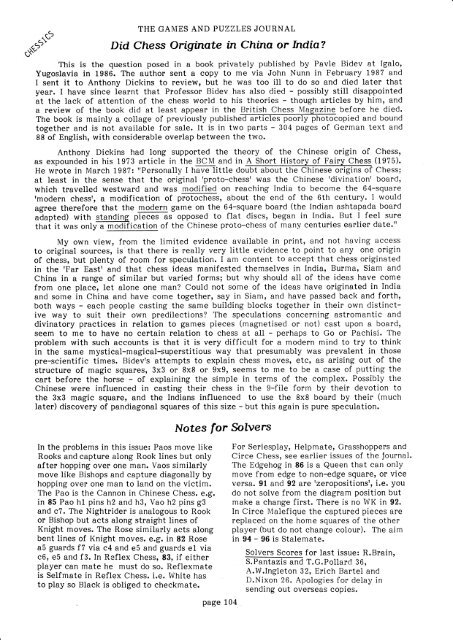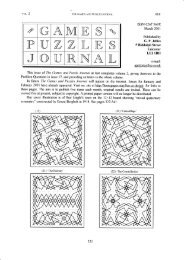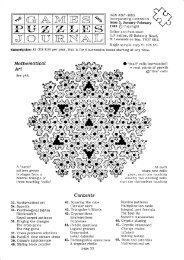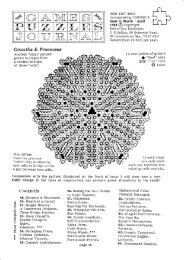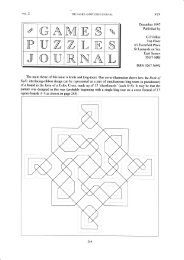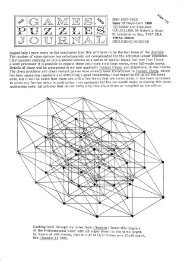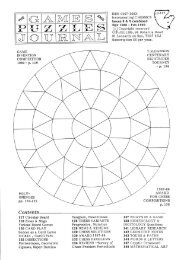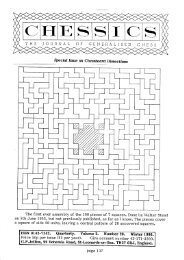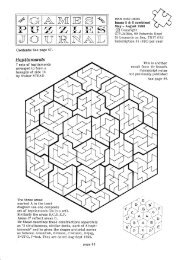The Games and Puzzles Journal, #7 - Mayhematics
The Games and Puzzles Journal, #7 - Mayhematics
The Games and Puzzles Journal, #7 - Mayhematics
Create successful ePaper yourself
Turn your PDF publications into a flip-book with our unique Google optimized e-Paper software.
dThis is the question posed in a book privately published by Pavle Bidev at lgalo'Yugoslavia in 1986. <strong>The</strong> author sent a copy to me via John Nunn in February 1987 <strong>and</strong>I sent it to Anthony Dickins to review, but he was too ill to do so <strong>and</strong> died later thatyear. I have since learnt that Professor Bidev has also died - possibly still disappointedat the lack of attention of the chess world to his theories - though articles by him, <strong>and</strong>a review of the book did at least appear in the British Chess Magazine before he died.<strong>The</strong> book is mainly a coliage of previously published articles poorly photocopied <strong>and</strong> boundtogether <strong>and</strong> is not available for sale. It is in two parts - 304 pages of German text <strong>and</strong>88 of English, with considerable overlap between the two.THE GAMES AND PUZZLES JOUR,I.IALDid Chess Origurate tn Chena or Indi.o?Anthony Dickins had long supported the theory of the Chinese origin of Chess,as expounded in his L9?3 article in the BCM <strong>and</strong> in A Short History of Fairy Chess (1975).HewroteinMarch198?:''PersonallytnaveJittIeooChess;at least in the sense that the original 'proto-chess' was the Chinese rdivinationr board'which travelled westward <strong>and</strong> was modified on reaching India to become the 64-squaretmodern chesst, a modification of protocness, about the end of the 6th century. I woulcagree therefore that the modern game on the 64-square board (the InOian ashtapada boarca-apted) with st<strong>and</strong>ing pieces as opposed to ftat discs, began in India. But I feel suretnai it was onlyTG-odification of the Chinese proto-chess of many centuries earlier date."My own view, from the limited evidence available in print, <strong>and</strong> not having accessto original sources, is that there is really very little evidence to point to any one originof chess, but plenty of room for speculation. I am content to accept that chess originatedin the rFar Eastt <strong>and</strong> that chess ideas manifested themselves in India, Burma, Siam <strong>and</strong>China in a range of similar but varied forms; but why should all of the ideas have comefrom one place, let alone one man? Could not some of the ideas have originated in India<strong>and</strong> some in China <strong>and</strong> have come together, say in Siam, <strong>and</strong> have passed back <strong>and</strong> forth,both ways - each people casting the same building blocks together in their own distinctiveway to suit their own predilections? <strong>The</strong> speculations concerning astromantic <strong>and</strong>divinatory practices in relation to games pieces (magnetised or not) cast upon a board,seem to me to have no certain relation to chess at all - perhaps to Go or Pachisi. <strong>The</strong>problem with such accounts is that it is very difficult for a modern mind to try to thinkin the same mystical-magical-superstitious way that presumably was prevalent in thosepre-scientific times. Bidev's attempts to explain chess moves, etc, as arising out of thestructure of magic squares, 3x3 or 8x8 or 9x9, seems to me to be a case of putting thecart before the horse - of explaining the simple in terms of the complex. Possibly theChinese were influenced in casting their chess in the 9-file form by their devotion tothe 3x3 magic square, <strong>and</strong> the Indians influenced to use the 8x8 board by their (muchlater) discovery of p<strong>and</strong>iagonal squares of this size - but this again is pure speculation.In the problems in this issue: Paos move likeRooks <strong>and</strong> capture along Rook lines but onlyafter hopping over one man. Vaos similarlymove like Bishops <strong>and</strong> capture diagonally byhopping over one man to l<strong>and</strong> on the victim.<strong>The</strong> Pao is the Cannon in Chinese Chess. €.g.in 85 Pao hl pins h2 <strong>and</strong> h3, Vao h2 pins 93<strong>and</strong> c7 . <strong>The</strong> Nightrider is analogous to Rookor Bishop but acts along straight lines ofKnight moves. <strong>The</strong> Rose similarly acts alongbent lines of Knight moves. €.9. in 82 Rosea5 guards f7 via c4 <strong>and</strong> e5 <strong>and</strong> guards e1 viac6, e5 <strong>and</strong> f 3. In Reflex Chess, 83, if eitherplayer can mate he must do so. Reflexmateis Selfmate in Reflex Chess. i.€. White hasto ptay so Black is obliged to checkmate.Notes for Solverspage 1 04For Seriesplay, Helpmat€, Grasshoppers <strong>and</strong>Circe Chess, see earlier issues of the <strong>Journal</strong>.<strong>The</strong> Edgehog in 86 is a Queen that can onlymove from edge to non-edge square, or viceversa. 91 <strong>and</strong> gZ are tzeropositionst, i.e. youdo not solve from the diagram position butmake a change first. <strong>The</strong>re is no WK in 92.In Circe Malefique the captured pieces arereplaced on the home squares of the otherplayer (but do not change colour). <strong>The</strong> aimin 94 - 96 is Stalemate.Solvers Seores for last issue: R.Brain,T.G.Pollarcl 36,A.W.Ingleton 32, Erich Bartel <strong>and</strong>D.Nixon 26. Apologies for delay insending out overseas copies.


